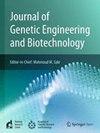Exploring the antibacterial potential of environmental Pseudomonas aeruginosa isolates: Insights from in vitro studies and genome mining approaches
IF 2.8
Q3 Biochemistry, Genetics and Molecular Biology
Journal of Genetic Engineering and Biotechnology
Pub Date : 2025-05-17
DOI:10.1016/j.jgeb.2025.100508
引用次数: 0
Abstract
Microorganisms are a significant source of antimicrobial agents, accounting for over half of the antibiotics used in healthcare today. This study focused on isolating and screening antibacterial microorganisms from soil samples, followed by a genome-based analysis of the most potent isolates. A total of 231 bacterial isolates were obtained from 63 soil samples collected across Dhaka, Sylhet, and Cox’s Bazar in Bangladesh. Among these, 51 isolates showed antibacterial activity in primary screening using the perpendicular streak method, while 28 exhibited activity in secondary screening via the agar well diffusion method against Escherichia coli ATCC35218, Staphylococcus aureus ATCC6538, Bacillus pumilus ATCC14884, Klebsiella aerogenes ATCC13048, Salmonella typhimurium ATCC13311, Pseudomonas aeruginosa ATCC9027, Micrococcus luteus ATCC10240, B. cereus ATCC10876, Proteus vulgaris ATCC8427, and B. subtilis ATCC6633. All primary screening positive isolates were identified via 16S rRNA analysis, revealing eight genera: Streptomyces (5), Sinomonas (1), Nocardiopsis (3), Arthrobacter (1), Micrococcus (1), Pseudomonas (27), Microbacterium (1) and Bacillus (6). The top five most promising isolates were identified as Pseudomonas aeruginosa, exhibiting strong antagonistic activity, and underwent whole-genome sequencing. Genome mining revealed multiple biosynthetic gene clusters (BGCs), indicating the production of known and unknown antimicrobial compounds, including Pf-5 pyoverdine, Azotobactin D, Pyochelin, and Pyoverdine SMX-1. This study is the first to combine whole-genome analysis with antibacterial activity assessment, highlighting Pseudomonas aeruginosa as a prolific source of bioactive secondary metabolites.
探索环境铜绿假单胞菌分离物的抗菌潜力:来自体外研究和基因组挖掘方法的见解
微生物是抗菌剂的重要来源,占当今医疗保健中使用的抗生素的一半以上。本研究的重点是从土壤样品中分离和筛选抗菌微生物,然后对最有效的分离物进行基因组分析。从孟加拉国达卡、锡尔赫特和考克斯巴扎尔地区收集的63份土壤样本中共获得231株细菌分离株。其中,51株用垂直条纹法对大肠杆菌ATCC35218、金黄色葡萄球菌ATCC6538、短小芽孢杆菌ATCC14884、产气克雷伯菌ATCC13048、鼠伤寒沙门氏菌ATCC13311、铜绿假单胞菌ATCC9027、黄体微球菌ATCC10240、蜡样芽孢杆菌ATCC10876、普通变形杆菌ATCC8427、枯草芽孢杆菌ATCC6633进行了二级筛选,28株用琼脂孔扩散法对枯草芽孢杆菌ATCC6633有抑菌活性。所有初筛阳性分离株均经16S rRNA分析鉴定为8属:链霉菌(5属)、单胞菌(1属)、诺卡多菌(3属)、节杆菌(1属)、微球菌(1属)、假单胞菌(27属)、微杆菌(1属)和芽孢杆菌(6属)。前5个最有希望的分离株被鉴定为铜绿假单胞菌,表现出很强的拮抗活性,并进行了全基因组测序。基因组挖掘发现了多个生物合成基因簇(bgc),表明生产已知和未知的抗菌化合物,包括Pf-5 pyoverdine, Azotobactin D, Pyochelin和pyoverdine SMX-1。这项研究首次将全基因组分析与抗菌活性评估结合起来,强调铜绿假单胞菌是生物活性次级代谢物的丰富来源。
本文章由计算机程序翻译,如有差异,请以英文原文为准。
求助全文
约1分钟内获得全文
求助全文
来源期刊

Journal of Genetic Engineering and Biotechnology
Biochemistry, Genetics and Molecular Biology-Biotechnology
CiteScore
5.70
自引率
5.70%
发文量
159
审稿时长
16 weeks
期刊介绍:
Journal of genetic engineering and biotechnology is devoted to rapid publication of full-length research papers that leads to significant contribution in advancing knowledge in genetic engineering and biotechnology and provide novel perspectives in this research area. JGEB includes all major themes related to genetic engineering and recombinant DNA. The area of interest of JGEB includes but not restricted to: •Plant genetics •Animal genetics •Bacterial enzymes •Agricultural Biotechnology, •Biochemistry, •Biophysics, •Bioinformatics, •Environmental Biotechnology, •Industrial Biotechnology, •Microbial biotechnology, •Medical Biotechnology, •Bioenergy, Biosafety, •Biosecurity, •Bioethics, •GMOS, •Genomic, •Proteomic JGEB accepts
 求助内容:
求助内容: 应助结果提醒方式:
应助结果提醒方式:


